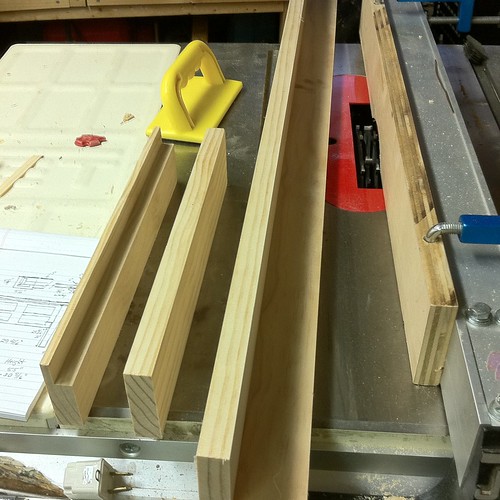Toolbox Tuesday has been on a little bit of a hiatus over the last few weeks. We've been super busy and I didn't have anything it my repertoire of tools that particularly inspired me, but this week I'm getting back on the horse. Over the past several days I've been using our dado blade somewhat extensively for various projects, and each time I use it I say to myself, "Wow, this blade is awesome, I'm so glad I bought it!"
Many Toolbox Tuesdays ago I covered the table saw that we bought way back in 2003 and how it has become an integral part in many of our renovation projects. The table saw came with a fine tooth 10" blade that has been great for everything from ripping lumber to my very amateur furniture making projects. But I have to be honest, there came a time in my woodworking endeavors when I needed to carve out a 3/4" wide groove into a piece of wood, and our single stock 1/8" wide saw blade just wouldn't cut it... no pun intended.
That's where my prized 8" Freud stacked dado blade enters the fray. For a long time I didn't really understand the usefulness of a dado blade. I figured you could just make a lot of passes with a normal blade if necessary, so why spend over $100 on a saw blade. That was before I started watching a lot of New Yankee Workshop. Watching Norm Abrams do a little bit of woodworking really opened my eyes to the potential of this amazing tool.
After I realized the benefit of the dado blade I just needed to tackle a project that would require that I follow my golden rule of tool purchases (remember: when building a tool collection use each project as a justification to buy a good tool that you don't yet own). I think I bought it when we started working on the desk in our office, and WOW, am I ever glad I decided to take the plunge to pick up this blade.
When buying a dado blade you have a ton of options. You can get a simple stacked dado (where you add and remove blades for the right thickness), dial a dado (where you turn a wheel on the side of the blade to get the right thickness), 6" dado, 8" dado, a safety dado, etc. There are so many options, and each comes with a price. For our needs I opted for an 8" multi blade dado from Freud. It's not particularly fancy or full of any bells and whistles, but it does the job and does it well.
Freud has a great reputation in the precision blade and bit industry, and their dado blades do not disappoint. Just take a peek at the various reviews on their blades on Amazon.com. The price range for their dado sets go from the low $100s to over $200, depending on what features and sizes you are looking for. For our needs, the standard 8" dado in the typical stacking formation seemed like the best option. It was the size that would work best on our saw and also one of the better prices.
The blade arrived in a carry case and contained two primary cutting blades that look like standard saw blades, and five chipper heads (four 1/8" thickness and one 1/16") that sit between the side blades. There is also a set of varying width shims for the micro adjustments that are sometimes necessary for that perfect fit.
You also have to be sure to buy a dado insert for your table saw, otherwise you will be out of luck when you attach the blade and try to raise it up through your standard slot insert. For whatever reason, I didn't think of this when I first ordered the blade and had a little head scratching moment when I went to set it up. That problem was easily solved, but just make sure you get one that works with your particular brand of table saw.
To say we've used this blade extensively is a true understatement. I never knew just how much I needed it until I was using it on a regular basis. Thinking back over the last five or six years, there isn't a major project that I can think of that required any level of woodworking where we haven't used this blade. Whether we're cutting a rabbet relief in a simple headboard project for a better joint...
...Or cutting a slot in the large extension piece for our new doors...
...This saw blade is always nearby my workbench.
One other note about the this particular blade set, the guess and check of setup is largely eliminated by the great configuration PDF that Freud has on their website. Just measure the thickness you need to cut, look it up on their table, and the chart tells you specifically which cutters, choppers, and shims you will need to use to get the perfect cut.
Do you have a dado blade you particularly enjoy? Maybe on of the crazy cool dial-a-dados? Let me know, I'd love to hear about some other experiences.
Did you enjoy reading this post? Want to learn more about our first-hand experiences with other tools, devices or items used throughout our renovation? If so, check out our complete list of product reviews in our Toolbox Tuesday section.
Note: We weren't compensated for this review. We simply want to share good products when we see them, and hope that learning from our mistakes can help save you time, money and frustration.

![]()
![]()